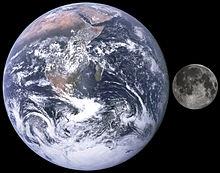
Moons — also called natural satellites — come in many shapes, sizes and types. They are generally solid bodies, and few have atmospheres. Most planetary moons probably formed from the discs of gas and dust circulating around planets in the early solar system.
Earth’s Moon probably formed when a large body about the size of Mars collided with Earth, ejecting a lot of material from our planet into orbit. Debris from the early Earth and the impacting body accumulated to form the Moon approximately 4.5 billion years ago (the age of the oldest collected lunar rocks). Twelve American astronauts landed on the Moon during NASA’s Apollo program from 1969 to 1972, studying the Moon and bringing back rock samples.
Usually the term moon brings to mind a spherical object, like Earth’s Moon. The two moons of Mars, Phobos and Deimos, are different. While both have nearly circular orbits and travel close to the plane of the planet’s equator, they are lumpy and dark. Phobos is slowly drawing closer to Mars and could crash into the planet in 40 or 50 million years. Or the planet’s gravity might break Phobos apart, creating a thin ring around Mars.
Credit : NASA Science
Picture Credit : Google




